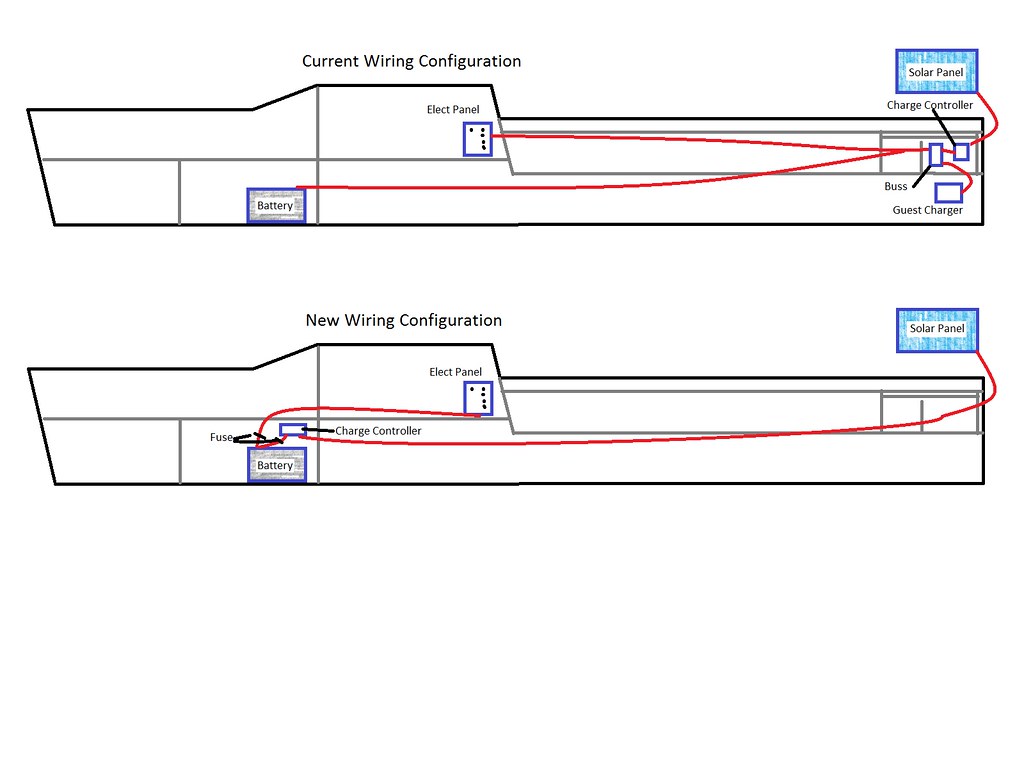Last season I kept seeing these weird, cyclical drops in voltage, to the point that the GPS/Chartplotter would throw a low voltage alarm. The solar panel charge controller showed a green light when the panel was plugged in and unplugging it had no effect on the fluctuations. I checked the wiring, tightened up the screws and redid a couple of crimp connectors.
That seemed to help, but by mid-season I had to replace the battery. The voltage cycling continued but seemed to throw alarms less often. The new battery didn't seem to hold the same voltage as the old one (when new) but I chocked that up to different manufacturers.
Fast forward to last weekend. I've got a new multimeter and the sun was out, so I decided to go check on the boat and take a look at the wiring while I was at it.
Eventually I worked my way back to the stern battery locker (my battery is in the v-berth) where I started to test the connections there. When I got to the charge controller I was a bit baffled to find 12.7v on the power in and power out sides, especially since the panel was putting out 20-22v depending on whether the sun was behind a cloud or not. And the green "ok" light was on. Hmmm. I disconnected the charge controller and did some testing with it only connected to the panel. 20-22v at the power in, fluctuating 3-4v at the power out. Ah ha! It's dead! I guess 5 years of nearly constant use, in a not very dry battery locker, was too much for it.
I drove down to the local RV place to see what they have. $150 for a controller capable of charging 4 banks of batteries, but only intended for dry applications. Uh, no, I don't think so. He did give me a website with the exact replacement (except with a blue case) for the dead Sunsei controller. I went home and did some research. There aren't many inexpensive (less than $150) options that are appropriate for a small sailboat. One option is the SunSaver line, which has all of the electronics sealed in epoxy. Perfect! Not waterproof but way better than the exposed breadboard on the Sunsei, so I ordered one.
This one looks to be "smarter" than the old one, plus it has an extra set of connections for a direct load from the solar panel. That will come in handy if/when I decide to put a powered vent in. A powered vent or fan won't get any light under the tarp in the winter but it will if it's hooked up to a solar panel. Hmmm.
Today I ran to Knechts for some wire, fuses, and connectors so I can hook things up. I've been mulling over the way the wires run from the battery in the v-berth, back to the stern battery compartment, then to the electrical panel. Everything is connected together, including the 120v Guest Charger that boils batteries, and I really don't like that. Plus it seems like an inordinately long run for no good purpose. The manual for the SunSaver calls for the controller to be within about 6 feet of the battery, which means it goes in the cabin. Sounds like a new wiring plan is needed. Here's what I came up with . .
I'm basically doing away with all of the connections in the stern except for the solar panel. The Guest Charger will come out, though I'll leave the 120v outlet and extension cord; those are handy when I need to run a shop vac or other 120v tool on the trailer.
Depending on the wire size, I'll either reuse the existing wire that runs from the stern to the battery for the solar panel or I'll replace the run with the 10AWG wire I bought today. I'll pull the original battery cables out and run them forward to the battery; I hope they'll be long enough that I can just reroute them without having to add an extension. That will give me a single run from the solar panel to the controller/battery and another, shorter, run from the battery to the main breaker panel. I think that will be more efficient and less prone to issues. I'll add fuses to both lines (battery/main panel and solar controller/battery) which should improve the overall safety of the system (there are no fuses now).
Should be an interesting adventure tomorrow . . .




No comments:
Post a Comment